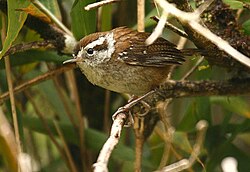Description
The timberline wren is 10 cm (3.9 in) long and weighs 14 g (0.49 oz). The adult of the nominate subspecies has rich chestnut brown crown and upperparts and a reddish brown tail with thin dark bars. It has a broad gray-white supercilium, a chocolate brown stripe behind the eye, and grayish cheeks with narrow black markings. Its throat and chest are grayish white, its upper belly a mottled grayish white, its lower belly brown, and its flanks and vent area reddish brown. The juvenile is grayer below with a scalloped appearance. T. b. ridgwayi is larger than the nominate and has deeper reddish brown upperparts. T. b. basultoi has a wider supercilium, whitish markings on the upperparts and the sides of its neck, and has whiter underparts. [3]
Distribution and habitat
The timberline wren's range is disjunct, and spans from central Costa Rica south to northern Panama. T. b. ridgwayi is found on Volcán Turrialba, Volcán Irazú, and adjacent areas in central Costa Rica. T. b. basultoi is found in the Cordillera de Dota of south central Costa Rica. The nominate T. b. browni is found on Volcán Barú, Volcán de Chiriquí, and Cerro Copete in western Panama. [3] [4]
The timberline wren inhabits páramo and near-páramo moorland at the upper edge of tree line, and is partial to bamboo thickets. In elevation it mostly ranges between 2,800 and 3,600 m (9,200 and 11,800 ft) but can be found as low as 2,200 m (7,200 ft). [3]
This page is based on this
Wikipedia article Text is available under the
CC BY-SA 4.0 license; additional terms may apply.
Images, videos and audio are available under their respective licenses.



